Entries Tagged as 'Henry'
Last week I attended another Bowthorpe Explorer Scout Meeting. We spent the entire time working on the troop’s IT Badge. I was in charge of leading three of the eight scouts present at the meeting through the requirements of the badge.
The first requirement we discussed was how technology can help make jobs easier to do. Then we moved on to discussing computer viruses and internet safety. After that came the fun part…
During the second half of the meeting each one of the Scouts had to create a spreadsheet and a powerpoint presentation based on a subject of their choice. Since it was one scout’s birthday she brought in Celebrations to share with everyone at the meeting. She was so excited about the candy that she decided to create her powerpoint presentation based on this subject as well. Needless to say it was not the most scholarly of topics but she understood the point of the exercise which was to learn how to use a computer to convey information within a slideshow type medium. Overall I was very impressed.
After all of the scouts finished up their powerpoint presentations and spreadsheets we headed into the main hall where we played a rope game. This was a “team building exercise” that I had never seen before. All of the scouts except for one formed a circle around a large rope. Then everyone picked up the rope and pulled as tightly as possible until it was taut and elevated about three feet off the ground. After the rope was elevated one scout climbed on top and the goal was for him or her to get all the way around the circle without touching the ground. We started out with the smallest scout and she made her way around the circle with no issues. Then things got a bit more difficult. Before I knew it, it was my turn. Climbing ropes/balancing in general was never one of my fortes in elementary school and entering the meeting last Friday I was still not very confident in my ability. Despite my fear however I made it all the way around without touching the ground! I certainly do not plan on entering the circus anytime soon and I have to give the other scouts a LOT of credit for keeping the rope nice and taut but overall I was impressed by my newfound tightrope walking abilities.
No matter how old or experienced you are at something sometimes you need others to help you achieve a goal. Without the other scouts helping me out I would never have made it around that circle, no matter how perfect or imperfect my balance is. Scouting is an organization that has always encouraged people to learn how to work together and solve problems collectively. This is a skill that they will need for the rest of their lives. This was the first activity with the Explorer Scouts in which I truly felt that everyone worked well together as a group. This was an incredible feeling.
At the conclusion of last week’s meeting I realized just how comfortable I have become with many of the Explorer Scouts and leaders that I have been working with over the past two months. At first many of the scouts didn’t seem to know what to think of me but now they do not hesitate for a moment to say “hiya” to me and ask how I am doing. While in Norwich earlier this week one of the scouts happened to see me and came over and said hello. This was a very kind gesture and something that I would not have expected to happen even two weeks ago. I feel as though I am part of their community now and that is a wonderful feeling to have as I continue to volunteer with this group.
Hours: 3
Total Hours: 12.5
Tags: Henry
February 19th, 2010 · 2 Comments
This week I completed four more hours of the experiential component of my Humanities 310 project.
If you happened to be shopping at Morrison’s between the hours of 11.00 and 13.00 on Wednesday than you may have seen me in my scout uniform bagging groceries with the Explorer scout group I volunteer with… Yes that’s right, bagging groceries. In the U.S. helping out at the local supermarket would never be considered community service since almost every store employs grocery baggers. In England however bagging groceries as community service makes a lot of sense.
Because you can take the 25 or 35 bus directly to and from Morrisons a lot of older people tend to shop there since there is less walking involved. Often times these older people have difficulties bagging their own groceries. That’s where the scouts come in. Although I found it a bit awkward at first asking people if they wanted their groceries bagged for them most people were quite happy to not have to do it themselves. Even many of the younger shoppers complied. One young customer’s face lit up in a similar fashion to mine every time I go to a gas station in New Jersey. Overall it was a good experience doing some community service in Norwich. All of the scouts seemed to really enjoy themselves and Morrisons really appreciated our help. Ever since I stopped bagging groceries in high school I never thought I would have to do it again but this time it felt as though I was doing something worthwhile.
Tonight I attended another Explorer Scout meeting. Lucky for me there was no twenty minute walk involved as we met in Earlham Park for a “Scoutwide Game Night”. This meant that both the Cub Scouts (Ages 10-13) and Explorer Scouts (ages 14-18) were present. After distributing glow sticks to everyone we headed down towards the center of Earlham Park where we played two hours of “The Peg Game”. I had never heard of this game before but it was actually pretty fun. We were divided up into two teams. One team was made up of “attackers” and the other team was “defenders”. There was a clothesline strung between two trees about 4 feet off the ground. The glow sticks were put in a circle surrounding the clothesline. The “attackers” were given clothespins or “pegs” and the goal was to attach them to the clothesline without being tagged. The “defenders” goal was to tag the “attackers” before they got inside the glow stick circle. If tagged the attacker would have to forfeit his/her peg to the defender. Whichever team had more pegs at the end would win the round.
During the first round I was an attacker. I managed to get a few pins on the line before the round was over and my team emerged victorious! Being a defender was not as fun. You had to be more stationary and it was difficult to spot the attackers running full speed through the woods. We switched sides two more times and before I knew it it was almost 9:30. My legs were quite tired from all the running by the end. It had been awhile since I played a game like that but I really enjoyed it. I even got told I was a fast runner by a ten year old. Although I would beg to differ if that’s not a good compliment than I don’t know what is.
One thing i’ve begun to notice about scouting here compared to the U.S. is that it’s geared more towards the social aspects than the rank advancements. Although I have helped the Explorer Scouts work on their cooking badge, the other meeting I attended we made troop t-shirts and last week when I was in Denmark they went bowling. Originally I thought it was odd that a scout meeting was scheduled on a Friday night from 7:30-9:30 but because of how social a group it is for these kids it now makes perfect sense. All the scouts present really seem to enjoy themselves at meetings and everyone seems genuinely excited to be part of the group. This is more than I can say about many scouts that I have encountered in the U.S.
Volunteer Hours: 4
Total: 9.5
Tags: Henry
January 29th, 2010 · 2 Comments
This evening I attended my second Explorer Scout Meeting. I was driven to the last meeting so this was the first time that I had to find the location on my own. Utilizing Google Maps and my Norwich A to Z to their fullest I calculated that it would actually be faster for me to walk to the meeting instead of taking a 21 or 22 bus (23 minutes vs. 29 minutes). This seemed like a great idea until it started, snowing, raining, sleeting etc. Nevertheless I bundled up, braved the elements and trudged my way over towards Bowthorpe Road hoping for the best.
Upon arrival (5 minutes early!) I greeted the troop leader, Lesley, and the scouts that I had met at the previous meeting. Glad to be inside I shed a few layers and prepared for the opening ceremony. When I was home over winter break I decided to bring my scout shirt back with me to wear at meetings/other events. The scouts found it very interesting and we spent a considerable amount of time discussing the similarities and differences between my uniform and theirs.
After witnessing a flag ceremony I was informed that the scouts would be working on making/decorating troop t-shirts at the meeting. My primary job consisted of cutting out cardboard squares for the scouts to mount their completed t-shirts on. This was so the paint they were using to decorate them would dry easier. This task took me longer than I expected since my pocketknife was getting a little dull.
As the scouts were decorating their t-shirts I chatted with them about various subjects. Two weeks ago the scouts attended Wintercamp at Gilwell Park, just outside of London. Since I plan on visiting Gilwell within the next few weeks I asked the scouts about their winter camp experience and about the park itself.
One scout was decorating his t-shirt in the colors of Norwich FC because he is a big fan. When I informed him that I was attending the Norwich vs. Hartlepool match tomorrow he was quite jealous.
We also spent a lot of time talking about education in the U.K. since a few of these scouts are preparing to take their A-Levels. They asked me what I was studying at UEA and if I was enjoying my time in England. Many of the scouts had very different academic interests but all seemed pretty sure of what they wanted to do as a career. I found this interesting. When I was 16 or 17 I had absolutely no idea what I wanted to major in at College, let alone know what I wanted to do for the rest of my life. Even now I am unsure/change my mind from time to time. Since many of the students that I have met at UEA seem to have their future planned out as well I wonder whether it is simply a cultural phenomenon that American students are generally not as decisive at an early age as English students when it comes to careers. Maybe it was just that I, and many of my friends, knew that we wanted to attend liberal arts colleges but I think I am on to something here.
After cleaning up all the supplies I witnessed an awards ceremony and we concluded the meeting. I was given a “Programme of Events” for the rest of the spring so now I know what the scouts will be working on from meeting to meeting. After saying goodbye to everyone I put back on my layers and made my way back out into the cold. Having found my way there I knew my way back comfortably and walked at a brisk Kelley pace, returning to the village in just under 20 minutes.
Although I hurried back to the village because of the cold I realized on my walk back that I would really like to explore more of Norwich, especially the parts outside of the city centre. As I spent more and more time at Dickinson I began to walk around and explore Carlisle a little bit and actually stumbled upon some pretty cool things. I’m sure Norwich will have similar if not greater surprises waiting for me. Once the weather warms up this will be my adventure.
Volunteer Hours: 2.5
Total: 5.5
Tags: Henry
January 25th, 2010 · 2 Comments
For my Humanities 310 research project I am observing the influence that scouting has had on youth in Norfolk both now and throughout its history here. My experiential component will involve scouting as well. In late November I linked up with a group of Explorer Scouts in Norwich. I have attended one meeting already (more details below) and will be attending weekly two hour meetings every Friday for the remainder of my time at UEA. In addition to my volunteer work I have added another experiential component. Since one can be a scout until age 25 in the U.K. (versus 18 in the U.S.) I have joined a local scout Network for 18-25 year olds. I have already gone on one kayaking trip with this group prior to winter break (more details below) and plan on attending additional group functions with them this semester as well.
Basic Background of Scouting
The concept of scouting was created in 1907 by Robert Baden Powell, a retired Lieutenant in the British Army. Powell believed that British nationalism was dwindling so he pioneered the idea of creating camps for young men to hone their physical, moral and mental abilities in hopes that training the youth in these values would lead Britain towards a brighter future . In 1908 Powell published Scouting For Boys, the original text that sparked the scouting movement. Powell’s book continues to be one of the most widely read texts of all time. The idea of scouting spread like wildfire and over the next few years many countries began to develop scouting programs of their own. The Boy Scouts of America got their start in 1910. This Summer’s National Scout Jamboree, held in Fort A.P. Hill, VA marks the 100th anniversary of scouting in the U.S. Today there are over 200 countries that have scouting organizations. It remains the largest youth organization in the world.
Volunteer Experience
I had a pretty good idea from the moment I arrived in Norwich that I wanted to get involved with a local scouting group in some way. I began to search for groups back in October. Finally through an organization called “Vinvolved” that was present at the Job and Volunteer fair in the LCR in the fall, I was given the contact information of the Norfolk Chapter Scout Executive, Mike Clemo. After corresponding with Mike I discovered that the Norfolk scout headquarters was located in Norwich, not that far away from Sainsbury’s. I asked Mike if I could stop in one morning to meet with him and take a look at the scouting headquarters and he agreed. During our meeting I asked him about possible volunteer opportunities with local scout troops. After telling him that I would prefer to work with the 14-18 age group he assigned me to a group of Explorer Scouts that meet weekly off of Bowthorpe Road. I got a ride to a meeting in the fall with David, another scout executive that I met with, and really enjoyed the first meeting I attended.
The biggest difference between scouting in the U.S. and scouting in the U.K. is that it is co-educational here. Although this was not something I was used to I actually thought the meeting ran fairly smoothly with both sexes present. During the meeting the scouts were working on their Cooking Badge and had to bake two cakes. They had chosen the week before to make a pineapple upside down cake and a chocolate and orange cake. Both cakes sounded rather exotic to me but I was pleasantly surprised with the results. My first immediate observation as I began helping out was that I could distinguish a similar accent among most of the scouts present. Just like in London when we didn’t get an accurate sense of “Englishness” because we were in a major international city, I felt as though I had not fully grasped what a Norfolk/Norwich accent sounded like since most of the time I find myself interacting with students from all over the country and the world. It was pretty cool to finally discover that a bunch of people actually spoke with a similar accent in one location. Overall I noticed more similarities than differences between U.S. scouts and U.K. scouts during my first meeting. Like with any group natural leaders emerged and some people put in more work then others. Overall the uniforms were pretty comparable but I didn’t get a chance to observe that too closely. I look forward to attending more meetings in the coming weeks, getting to know the scouts better and continuing to learn about the similarities and differences between scouting here and back in the U.S.
2 hours complete
Norfolk Network Kayaking Experience
I mentioned above that I had a chance to go kayaking with the Norfolk Network group in the fall. We went to Swanton Morley , a small village about 15 minutes northwest of Norwich. Here there are a few small streams that eventually turn into the Norwich Broads if you follow them long enough. It was a cold, rainy, early December day and we were encouraged to bundle up as much as possible. Eight of us kayaked for about two hours before the rain started to pick up and things became a little less enjoyable. After carrying our boats back to shore and changing out of our wet clothes we headed off to a local pub where we grabbed some lunch. Out of the eight of us present five of us were new to the Norfolk Network. There was a scout on the trip from Finland and another from Romania. It was fascinating to discuss our varying international scouting experiences. All in all this was a wonderful trip. I met some great people and I hope that there will be more events coming up in the near future.
Tags: Henry
September 15th, 2009 · No Comments
-
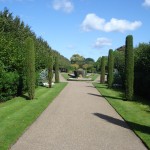
-
Regents Park
-
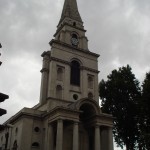
-
Christ’s Church
-
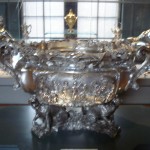
-
The Silver Exhibit in the V&A
-
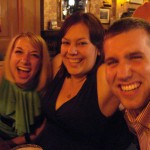
-
Having a Good Time at the Fitzroy
Like many of my classmates I decided it would be worthwhile to summarize all of my discoveries this month in London. During this post I will focus on six main themes found within London: Parks, Churches, Pubs, Other Religious Institutions, Theatre and Museums.
Parks
Each park that I visited had its own distinct characteristics that separated it from any other. Green Park was the first I visited and after perusing a few others, I realized there was nothing that exciting about it. Located right across from Buckingham Palace, Green Park certainly provides a good place to go and take a break from the busy atmosphere of the area. Besides this however there is not much going on and I would recommend that potential park goers walk the extra distance over to St. James Park.
In addition to the large number of waterfowl heckling people for food which offers consistent entertainment St. James offers some picturesque flower beds throughout and various monuments along the way. It has the relaxing atmosphere of Green Park with a bit more excitement sprinkled in.
Regents Park offers a completely different feel from Green or St. James. Located in a separate area of London, Regents Park has a history of being used by a higher end crowd. I could tell this immediately from the feel of the park. The decorative shrubbery and elegant architecture throughout gave me a feeling that Regents is not as well used as other parks.
Since I was one of the members of the Parks group that gave a walking tour of Hyde Park and Kensington Gardens I could go into a lot more detail about these two green spaces but I will choose not to in an effort to be concise. In summary Hyde Park is the largest green space in London and is often used for larger events such as concerts, festivals etc. It also contains a large number of monuments throughout including the 7/7 memorial and the Diana Memorial Fountain. Kensington Gardens is home to a variety of key monuments but is not as well trodden as Hyde. Overall it makes for a quieter atmosphere, more conducive fo reading or “snogging”.
Regents Park were my two favorite green spaces in London. Regents, is both beautiful, and extremely large and I continually felt the need to go back and explore. Kensington Gardens appealed to me in that it was quainter than Hyde Park but contained a like amount of history and monuments throughout. Although I would be content spending a length of time in any London green space Regents and Kensington would be my top choices.
Theatre
Overall I enjoyed going to the theatre on so many occasions. What better place to do so than in London after all? Here I will discuss my favorite performances and theatre venues.
All in all I enjoyed all but two of the performances we saw. The two Shakespeare productions at The Globe Theatre were fantastic. Although I did not particularly enjoy reading Troilus and Cressida it made a huge difference to be there so close to the actors. The fantastic drum chorus at the end really sealed the deal. As You Like It was probably my favorite show I saw here in London. Although it is one of Shakespeare’s simpler plays the actors really made it jump off the page. Being down it the pit was fantastic because of all the ad-libbing and constant interaction with the crowd. I even felt traces of Touchstone’s saliva on my arm at one point.
The other Shakespeare performance I saw, All’s Well That Ends Well, was lackluster. Although the Olivier was my favorite performing venue (this is what an auditorium style theatre should be like…why can’t Dickinson have something like this?) the play itself was odd and ended on an abrupt and odd note.
The other play we saw at the National Theatre, The Pitmen Painters, was fantastic. Although I was dozing a bit because of the Benadryl I took right before the show, the actors kept my attention and I appreciated that the play was based off of a true story.
Easily the oddest play we saw was Arcadia. An extremely intelligent performance the play juxtaposed two different periods in time and created a singular storyline in which the plot was based. Overall it was an entertaining performance that made me think early and often.
Finally there was Blood Brothers. The lone musical I saw produced feelings of disbelief, anguish and held back laughter. The ridiculous 80’s sound track and creepy narrator just didn’t do it for me. I think it’s safe to say that I was not the only one from Humanities 309 who was a bit surprised to see just about everyone in the audience give it a standing ovation.
I had a very positive experience with the theatre here. I would go back to the globe again and again. I loved being that close to the action. I would also enjoy seeing another show in the Olivier. There really is so much to choose from here. It’s simply a matter of figuring out your tastes and saving your money so you can see a lot of performances.
Churches
From Westminster Abbey to St. Paul’s Cathedral we saw most of the major churches/cathedrals during our month in London. St. Paul’s was easily my favorite. From the fantastic crypt to the hundreds of stairs up to the tower it had so much to offer in the way of history and mystique. Westminster Abbey fascinated me primarily because of all the literary figures that had been buried inside as well as the room that was dedicated to “The Order of the Bath”. Other churches that I really enjoyed taking a look at were: “St. Martin in the Fields” which sits just outside Trafalgar Square and Nicholas Hawkesmoore’s “Christ’s Church” which is located in very close proximity to Brick Lane.
Other Religious Institutions
Overall the Sikh Gurdwara was my favorite place that we visited. I appreciated the simplicity of the religious doctrine as well as the conviction and honesty with which our tour guide, Mr. Singh spoke. The morning was capped off with a fantastic sit down meal together in which everyone was served the same food and drink.
I had different feelings about the Hindu Mandir. It was clear to me from the very beginning that the Hindu religion is not nearly as modest as Sikhism nor are they trying to be. From the extremely decorative prayer room, to the museum located right in the center of the Mandir I never felt particularly comfortable inside.
The only religious institution I wish we had gotten a chance to visit is a Mosque. I had been to one many years ago but I did not remember a whole lot from my experience. I wonder how much more lively the East End, and all parts of London would be if Ramadan were not taking place during our time here.
Museums
I could go on and on about museums so I will attempt to stay as concise as possible.
The British Museum was massive, convenient since it was so close to the Arran House but a little one dimensional at times. One of my favorite exhibits at the British Museum was a special exhibit on Living and Dying that drew information from all different time periods and cultures.
The National Gallery was fantastic. Although I have a hard time appreciating some visual art the gallery kept my attention for a number of hours. Seeing so many famous works of art was phenomenal.
The Tate Modern was my least favorite museum here. Although I am trying I have a hard time understanding modern art. After about 45 minutes in this museum it ended up being too much for me.
The Cabinet War Rooms/Churchill Museum were two of my favorites. The realization that I was standing in one of the most important places in World War II history was unbelievable. The War Rooms felt so authentic. I really felt as though I had been taken back in time to the 1940’s while inside.
The Victoria and Albert was easily my favorite museum in London. There was so much variety inside and so much to see. I could have easily spent a few days inside. Two of my favorite exhibits were the silver and jewelry exhibits. I’m not sure what this says about me as a person but I found it unbelievable that individuals could even own such treasures. I also enjoyed the laid back atmosphere of the V&A staff. At most of the other museums I visited I felt like I was doing them a disservice simply by being there. Although I understand that taking pictures of an object in a museum doesn’t do it justice I like to be able to have the option of doing so.
The Sir John Soane museum interested me but it wasn’t really my cup of tea in the end. It also had a stuffy atmosphere to it that I didn’t really appreciate.
One thing I can draw from my experience at museums here is that each and every one has something that distinguishes it. With so many museums I thought that it would be impossible to avoid some overlap but I never really felt that. Cheers to London and its museums.
Pubs
Finally we have pubs. What would London be without it’s public houses? In some cases pubs are the true museums of London, designating what an area was like in the past and what type of clientele it attracted. During my month here I had a chance to visit a few pubs and get a general sense of what some possible differences could be. It is clear to me that each pub brings something different and unique to the table. The Marlborough Arms was convenient being so close to the Arran House and was a great place to enjoy a pint over a meal with friends. The Court was conducive to socializing in a different way. The music was louder, the people louder and the drinks cheaper. Other places I visited offered other things that made them stand out as well. One thing that i’ve learned about pubs is that it’s hard for one to please everyone. Since everyone has different tastes and desires when it comes to pubs you are better off going to one with a small cohesive group.
To conclude this novel I would just like to say that I think we saw a lot of different faces of London this month. I realize there is much more to see here but between walking tours throughout the city, trips to major monuments and museums and individual exploration I have learned a ton about London, it’s history and where it is going. I look forward to more London explorations in the future but for now, ON TO NORWICH!
Tags: Churches and Cathedrals · Henry · Pubs · Theatre
September 13th, 2009 · No Comments
When someone asks me “where is a good pub?” I have a hard time responding. What exactly is a good pub? Each and every one brings something different to the table that makes it unique and appeal to a certain crowd. I will explain this simply by comparing and contrasting three of the places I frequented the most within the vicinity of the Arran House.
The “Marlborough Arms”, located just a minute from the Arran House was an extremely convenient place to go for the first few days here. After visiting a few other places I quickly learned that the Arms is best suited as a great place to grab a meal with friends (preferably on a weekday) since it features a complete traditional pub menu and ample seating. The bartenders there are friendly and welcoming and even make the effort to card people once in a while.
“The Court”, located on Tottenham Court road and about a five minute walk from the Arran House features a completely different atmosphere. If you’re looking to get a full dinner this is not the place to go. With a setup more like a college bar The Court is two floors with a decent amount of space to sit both inside and outside. Open late every night of the week the Court draws in a large crowd regardless of the evening. The jukebox is always blaring with pop and rock music and there are pool tables upstairs for anyone who’s feeling ambitious. The major draws for “The Court” are that the drinks are a bit cheaper overall and it draws in a younger crowd. While the average age at the Marlborough Arms was usually between 30 and 40 The Court drew in a mostly 18-28 crowd. This makes sense since it is located just a block away from The University of London.
Another place I frequented was called the “Bricklayers Arms”. Located just two blocks past Goodge Street Station and a block down Rathburn Street, I had gotten recommendations over and over again about the B.A. from people who had studied in London in the past. I soon learned that the major draw of the Bricklayers is twofold. One: it features the cheapest pints of ale around (2 pounds) and two: it serves Samuel Smith’s which is nearly impossible to find. Much like The Court, the Bricklayers Arms is not the place to go if you want a full dinner. It is also not the place to go if you want something besides ale since the selection is more limited than other pubs and isn’t really worth the price otherwise.
To connect my experience in London with George Orwell’s essay “The Moon Under Water” I appreciate that Orwell has his own criteria of what makes a good pub. Although I do not particularly agree with him in every case I like that he knows exactly what he’s looking for. Although I have some idea of what I like in a pub I will need to do much more exploring to find what exactly my tastes are. As Orwell so elegantly puts it: “I know pubs where the beer is good but you can’t get meals, others where you can get meals but are noisy and crowded, and others which are quiet but where the beer is generally sour.” This explains why there are so many pubs and why they all stay in business. I suppose like a man or woman there is a perfect pub out there for everyone too. Here in London we are all on a constant journey to find our own “Moon Under Water”.
Tags: Henry · Pubs
September 12th, 2009 · No Comments
During the past few days I have been trying to tie up a few loose ends before preparing for the big presentation Anya, Audrey, Maddie, Megan and I are putting on in front of the Alumni next Tuesday night while simultaneously packing for UEA. This morning I decided to visit the Sir John Soane Museum. Going into the visit I had heard very mixed feelings about it. Some of my classmates loved it while others did not at all.
One thing that distinguishes the Sir John Soane museum from other prominent London museums is that it is only open from 10 a.m. to 5 p.m. 6 days a week so people only have a slim window of time to visit. This morning I arrived in front of the museum five minutes before ten and there was already a queue of people lined up in front of me anxiously waiting to get in. Looking at the outside of 13 Lincoln’s Inn Fields nothing about the building struck me as spectacular. Once I stepped inside however this changed dramatically. The Sir John Soane museum essentially showcases all of Sir John’s home which contains, to put it colloquially, a whole lot o’ stuff. Walking through I wondered where he obtained many of the objects he had sitting throughout the building.
After walking through Sir John’s library and his two studies I made my way into his picture room. Here I was utterly amazed to see a multitude of works by William Hogarth, most prominently a series of paintings entitled ‘A Rake’s Progress‘ which Hogarth is best known for. ‘A Rakes Progress’ depicts the life of a man named Tom Rakewell who abandons the mother of his baby, makes poor choices and spirals his life out of control before going mad. Hogarth elegantly displays this transformation on eight works of art, all of which Sir John had hanging on the wall of his picture room.
The other part of the Soane museum that amazed me was the crypt. Down below Soane had a large variety of sculptures and other fascinating objects. Perhaps the most intriguing was the Sepulchral Chamber which featured the sarcophagus of King Seti I who ruled Egypt from 1303-1290 BC. Soane purchased the Sarcophagus from Giovanni Belzoni in 1824 outbidding the British museum and adding just another piece of history to his already vastly historical collection.
After completing my tour of Sir John’s humble abode I was struck by the sheer amount of objects Soane had in his home. In certain parts of the house there was almost no room to move around because there were so many things hanging on the walls. I can’t imagine anyone today keeping all of that fortune sitting around in their home. It would be stolen in a heartbeat. I also can’t imagine obtaining the sheer number of sculptures, paintings and trinkets that Soane had lying within.
——————————————-
On Thursday night our class saw a performance of the Pitmen Painters at the National Theatre. Based off of a true story the play focuses on the life of four miners and how their lives are transformed through their appreciation of art. What’s significant about the Pitmen Painters is that they have next to no material possessions, are some of the most simple minded fellows on the planet and are unable to think in the abstract. The catch is that they are content with their lives for the most part. They don’t need much else.
It’s funny how everyone’s definition of wealth is relative. When Oliver, one of the Pitmen Painters, started to appreciate art a whole new world was opened up to him and his life felt that much more expansive. The Pitmen Painters had a chance to go to London and upon coming back they saw that there was more out there than their little world in the mines. I wonder what Sir John Soane would do if the reverse happened and he had to spend a some time in the life of a Pitmen Painter? Somehow I think Soane would be a little bit thrown off. When you have the ability to get anything you want whenever you want it makes it hard to take a step back and take life as it comes to you.
But is it?
To connect this to William Shakespeare’s As You Like It (which we saw at the globe theatre on Thursday) i’d like to point out the example of Duke Senior who is usurped from his thrown and sent to the countryside where he forms his own court. Duke Senior is immediately thrown from a life of wealth and power into one of simplicity yet he seems to react completely unfazed. As we observe his actions throughout the play it actually seems that he enjoys the simplicity of country life a bit more. He welcomes in Orlando and Adam when they have nearly perished from starvation even though he does not have the unlimited supply of food to offer that he would have had as Duke.
————————————–
So…drawing from these three examples found right here in London I am about to get deeply philosophical. What is it we desire as students, with our Dickinson education that costs us thousands of dollars? Do we wish to live a life where material possessions run our lives and collecting antiques becomes simply a hobby? Or do we wish to live a life of simplicity where all that matters is what is immediately around us? I’m guessing most people will fall in the middle somewhere. We have made the choice to take this year to learn and be immersed in another culture. Even though the majority of people in England speak the same language as us we have already realized that there are vast cultural differences here beyond our wildest dreams. At the end of this trip we will have expanded our horizons and seen things that we’ve never had the opportunity to see before. That is a given. The key is what we take from these experiences. If there’s one thing i’ve learned from London so far it’s that things can change in a heartbeat here. It may be something as simple the weather, or something as vast as a new ethnic community moving into the east end. I hate to get cliche here but I think we can view London as a metaphor for life. There may be times where we find ourselves in Duke Senior’s situation where everything we thought was ours is completely taken away and we’re forced to adapt. Perhaps we’ll be faced with a life changing revelation like the Pitmen Painters when they discover art? Maybe we’ll even have the chance to live like Sir John Soane? All I know is that I am going to take in all I can of London in these next four days. Who knows what else can be found?
Tags: Henry · Museums · Theatre
-
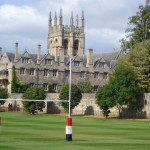
-
Christ Church and the Rugby Pitch
-
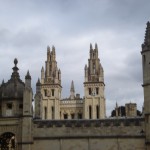
-
The University of Oxford
-
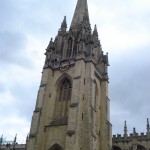
-
Cathedral
-
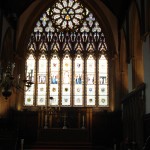
-
Chapel
Although this post is a bit belated I felt it was important to share my experience in Oxford last Saturday. After a relaxing hour train ride from Paddington Station to Oxford our class had some time to explore before our formal tour in the afternoon. Besides the university I did not know much about the town of Oxford going into the trip so naturally I was surprised to see huge mobs of people as I approached the main road. This sight immediately generated thoughts of the U.S. I felt like I could have just as easily been walking around Yaletown, New Haven or downtown Freeport with shopping centers and fast food restaurants lining the roads as far as the eye could see.
Anxious to get out of the bustling shopping area Brandon, Aidan and I followed our map down towards Christ Church, one of the many sites where the Harry Potter movies have been filmed. Since they were charging 3 pounds to enter the gates Brandon, Aidan and I decided to save our money and take pictures from the outside of the fantastic building. We walked around the back and found a long walkway that took us away further away from the town and back behind the university where we saw athletic fields and the magnificent Church in the distance. We decided to try to go to the Botanic Gardens only to find that the path was closed off and opted to head back towards the town instead.
Not to shift topics completely but lunch was an experience in itself. Brandon, Aidan and I entered a covered market that featured a variety of stores and small eateries. After walking throughout the market Aidan spotted a sandwich place that was selling pretty large sandwiches at a fairly affordable price. We decided to purchase sandwiches there despite the fact that there was no seating available in front of the eatery. Spotting a nearby cafe with 10-15 chairs available we decided that it looked like a promising spot to sit and enjoy our sandwiches. After about two bites we were approached by a random man who gave us a stern warning that we should not be sitting there since we did not buy the food from that eatery. He also mentioned something about needing room for he and his two kids to sit even though there were still ample chairs available. This man had no apparent connection to the restaurant, and no real reason to say anything to us. He simply just wanted to make his point known. Being the law abiding citizens we are we attempted to find another place to sit outside the market. After a few minutes of wandering we found a pizza express that appeared to be closed. Like the cafe there was plenty of seating outside and no business in sight. Sure enough however a woman emerged from the restaurant and told us we could not sit in front of the restaurant despite there being numerous seats available. Frustrated and a bit perturbed I held in my contempt and we attempted to find another place to sit. Due to the massive amounts of people on the streets none of the park benches were open so the three of us ended up eating our sandwiches in a back alley where no one could bother us for eating in front of their establishment.
If there is one pet peeve I have about London it’s that most restaurants don’t have enough places for people to sit and enjoy their food. In addition people become overly offended when you eat food you purchased elsewhere in front of another restaurant. It becomes a vicious cycle and leaves one with two options. The first option is to master the “walk and eat” technique which from keen observation it seems Londoners have figured out pretty well. The second option is to pull out the vagabond card and eat in a back alley or on the side of the street. Needless to say I have had to resort to the second technique quite a few times since my arrival in the U.K. Not to beat a dead horse but it seems to me that restaurants should provide enough seating for their clientele. In addition places that don’t have any business should be generous and allow anyone to eat outside their establishment. I know it goes against the rules of good business but personally I think the rules of common courtesy to fellow man are a bit more important…and with that I digress.
Between my distaste of downtown Oxford and my lunch experience I did not have a very good feeling going into the tour that afternoon. Thankfully this negative feeling would disappear once the tour got going. Our tour guide had the driest sense of humour I had ever encountered but he was very informative and knew a lot about the University of Oxford’s current setup as well as its history. Since I give tours for Dickinson and worked in the admissions office this past Summer my main interest while touring Oxford centered on how the British system of higher education differs from that of the states. I found it interesting that the British government actually requires Oxford to take up to 80 percent of its students from Public schools in the U.K. Traditionally institutions like Oxford and Cambridge have swept up private preparatory scholars like wildfire. Since Oxford is now being forced to take so many public school students I wonder how much the dynamic of the university has been changed. It was clear from what our tour guide said that there is a lot of distaste expressed by the University on this subject. Another thing that I found interesting about Oxford is how it was layed out into separate colleges which essentially function as completely separate institutions. Unlike the university system in the U.S. most of the colleges within Oxford offer classes in just about any subject area, almost like a collection of liberal arts colleges. Students actually apply for a specific college all of which have different traditions and reputations but are all considered part of The University of Oxford. The different colleges often compete against each other through both athletic and mental competitions and the best athletes from each college are chosen to compete on the University team, typically against Cambridge.
Walking around it was amazing to view architecture that was at least two times as old as Dickinson’s. The juxtaposition between the modern, tourist trap of a town and the old, traditional university was striking. Since the town seemed to be completely catered to the 21st century student I had a hard time believing him when our tour guide said that the town/gown relationship needed some improvement.
Overall I enjoyed the tour of the University of Oxford a lot. Although I am extremely lucky to be a student at a school like Dickinson and also fortunate to be attending UEA this year I can’t help but wonder what it would be like to attend Oxford. There is just so much history and tradition there and an unbelievable amount of prestige. I hope that when we visit Cambridge it offers a similar experience.
To compare Oxford to London would be like comparing apples and oranges. I noticed a much different, more touristy, less ethnically diverse and less friendly population at Oxford. As I continue to spend time in England I realize more and more that London seems to be an incredibly unique area within the entire country. As we move from the bubble of London to the countryside of Norwich next week I will be interested to see how Norwich fits in the grand scheme of things. What type of diversity will we experience among the student population at UEA and the Norwich population in general? These are questions that will remain unanswered for now.
Tags: Henry
September 7th, 2009 · 3 Comments
-
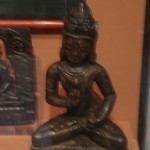
-
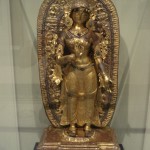
Going into the trip at the Sikh Gurdwara last Thursday I was unsure of what to expect. By the time I came out I felt very positive about the experience. Things could not have been more different for me at the Hindu Mandir. From the moment I saw the Temple and noticed that there were security guards in front I had an odd feeling. This did not go away. After depositing my bag and all my valuables in the security trailer across the street I made my way into the Mandir. After depositing my shoes in a rack similar to the Gurdwara our tour guide began speaking with us about the Hindu religion. After a quick introduction he began immediately by praising Hinduism and the Mandir pointing out the intricacies of the building including the ceiling which is made from a special wood found in Burma. Unlike Mr. Singh at the Gurdwara who was dressed in traditional Sikh prayer garb our guide at the Mandir was dressed in western attire with a button-up collared shirt and slacks. After walking through the humungous prayer room my hypothesis that Hinduism and Sikhism should be polarized with one another seemed pretty accurate. The prayer room featured one giant ornate rug that covered the majority of the room. On the walls there were giant portraits depicting the past four Spiritual Guru’s of the Swaminarayan Faith and lifesize statues of each. The prayer room also featured two giant projectors in the front of the room so those that are praying in the back of the room can get a phenomenal view of the front stage. In addition there were skylights located in the center of the hall that could be opened or closed at any time.
After hearing about the prayer room we crossed over to the other side of the Mandir where we entered an exhibit explaining the ins and outs of Hinduism. Although our guide said that the Mandir served a multi-purpose role not only as a place for people to pray but also a place where people can learn, I was still a little disconcerted by the presence of a museum in the middle of a place of worship. While waiting to enter the exhibit the class looked at a wall outside that featured pictures of all the famous world politicians that had come and visited in the past. The wall also featured certificates and awards that the Mandir had won.
Inside the museum I learned a lot about Hinduism but I couldn’t help but notice the lack of humility with which the information was presented. There were quotes from notable figures such as Mark Twain and Henry David Thoreau praising the Indian way of life and the Hindu religion. An example is:
“It is already becoming clear that a chapter which had a Western beginning will have to have an Indian ending if it is not to end the self-destruction of the human race…At this supremely dangerous moment in history, the only way of salvation for mankind is the Indian way” – Dr. Arnold Toynbee (British Historian. 1889-1975).
Other parts of the exhibit not so diplomatically claimed that the Hindu’s invented the concept of zero and created the first university over 2,700 years ago. Everything seemed glorified and most definitely biased. Although I expect every museum to have some sort of bias I did not expect it to be as brutally obvious as the Mandir made it seem.
To sum up my experiences at the Sikh Gurdwara and the Hindu Mandir it is safe to say that they were vastly different from one another. Since Hinduism is the oldest living religion in the world it makes sense for them to refer to many of their ways as “Indian”. Despite this fact I couldn’t help but notice that Sikh’s were being excluded when these descriptions were being made.
The best way to describe the Hindu religion and the Baps Shri Swaminarayan Mandir is immodest. Everything both in and outside was big, new and technologically driven. Even when our class had an opportunity to participate in a traditional Hindu prayer I found it hard to concentrate because there were security guards standing around the premises. Although the Sikh Gurdwara was certainly big and looked fairly new the message preached inside was of simplicity, the polar opposite of what I sensed at the Mandir. Although I still did not feel entirely comfortable paying my respects to the guru at the Gurdwara I felt that had I participated in prayer I could have felt at peace. Even something as small as just sitting down to a meal together was significant to me. Especially since every single Gurdwara serves the same meal to every single person everywhere. To me this example completely JUXTAPOSES the Hindu tradition of hierarchy rooted in their caste system. Since Sikhism is a fairly new religion and has not fully been recognized by much of the world there are bound to be some bumps in the road but it seems to me that part of the reason Sikhism was founded in India was to rebel against the values of Hinduism.
As far as where I see these two religions going within Great Britain it is hard to say. Both Southall and Neasden seemed to be pretty homogeneous communities with mostly people of Indian descent in both regions. Because of this I think that both the Hindu and Sikh religions will have their place within London, at least for a while. Using the example of Mrs. Suri in Tarquin Hall’s Salaam Brick Lane it seems that the Indian community remains tightly knit regardless of where members of the community immigrate to. The Indian community itself traditionally churns out millions of educated “youngsters” every year many of which go on to hold prominent positions in a variety of fields including business, law and medicine. Because of this the Indian community as a whole is in no danger of disintegrating anytime soon.
As Mr. Singh told us at the Gurdwara he wishes that a day will come when he can go to the security check point at an airport and the security guard will know that he is a Sikh, therefore a peaceful man, and let him pass without any hassle. Due to the fact that Sikhism is such a young and upcoming religion (according to the BBC there are 336,000 Sikhs currently living in Britain) one can only hope that over time and with more exposure in the U.K. people will come to understand it better and the Sikh’s will find their place here in London. The only obstacle I see Sikh’s facing is their ability to blend in to the professional work force here in London. Some businesses may require that men shave off their facial hair in an attempt to look more like the typical British professional. As a Sikh one would have to ask himself how much that part of his religion means to him and whether he feels like he is sacrificing anything by shaving. If the answer is that the Sikh feels like he is sacrificing something than it will be difficult to predict what will happen.
With Hinduism being the world’s oldest living religion it is clear that Hindu’s have managed to traverse many obstacles throughout the years. In addition, they have completely modernized their religion to fit 21st century standards. Although I did not enjoy my experience at the Mandir all that much I have to admit there is certainly a rare brilliance and resilience that comes with being a Hindu. With some of the world’s smartest, most self-motivated and disciplined individuals running the show Hinduism is not going anywhere in London or in the U.K. In fact I see it growing steadily, especially with all the adaptations Hindus have made to fit the times.
Tags: Henry
September 5th, 2009 · 2 Comments
-
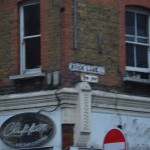
-
Brick Lane
-

-
Each Religion Can Be Beautiful in Its Own Right
On Wednesday our entire class went on a walk of London’s East End. After reading a few books this Summer dealing with this part of the city I had a very narrow view of what to expect before going on the tour. The East End is typically home to the most recent immigrant population of London which today is the large Bangladeshi community that has immigrated within the past 30 years. Most of the post colonial literature we read portrayed the east end and specifically Brick Lane as a dingy place where its inhabitants are trapped between their home culture and the culture of Great Britain. Often this leads to conflict and not the best living situation.
After hearing all of this negative portrayal of the East End I was surprised once we got away from Liverpool Street Station to see a quiet, unobtrusive Brick Lane. Part of this could have been attributed to Ramadan taking place which nearly all of the East End Bangladeshis observe. That being said it was evident a lot had changed in Brick Lane over the past few years. It was noticable that the city had been putting in a strong effort to change the dynamic of the area. As we concluded our walk and moved into a more well-off area near the Tower of London I realized that the image I had of the East End going into the tour was not close to what I had found. In fact the only thing that reminded me of the East End I read about was when I was riding west on the Central Line later that afternoon from Mile End to Bank and I noticed an incredible difference in the overall quality of the two Underground Stations. When hearing about Brick Lane I had expected something more akin to East St. Louis but instead found something closer to East Dublin or East Carlisle. Sarah made a great point in class today that the Brick Lane area seemed to have a bit of a “hipster” feel to it. To go along with this you’ll notice one of my hyperlinks above is connected to a series of restaurants on Brick Lane. Ten and maybe even five years ago this would never have happened. Although there were signs of immigrant communities in Brick Lane they did not become extremely noticeable until we got to the Whitechapel area. If Brick Lane is indeed becoming an area where the London mainstream is beginning to spend a good amount of time and money then where are the first generation immigrants being pushed to?
On Thursday we got to observe another area of London where immigration was prevalent as we headed to Southall, home to a large Indian community. Unlike the East End my first impression of Southall was just what I expected it to be. Walking through the area I noticed a very diverse Indian community consisting of people dressed both in western attire and in traditional south Asian clothing. Along the walk I noticed a few Churches which told me that the community has assimilated into the greater British culture a little bit. After a few more minutes of exploration we arrived outside the Gurdwara Sri Guru Singh Sabha, put scarves over our heads and prepared to head inside. Upon entering the first thing I noticed were the separate areas for men and women to hand over their shoes and cleanse themselves before prayer. The only experience I had to compare this to was when I visited a mosque many years ago and the same process took place. As we entered the main hall and waited to begin our tour I took in my surroundings. There was a man writing Punjabi on a whiteboard and a collection of men women and children wandering throughout, praying and meditating but most of all staring at the group of 28 Americans standing in the middle of the Gurdwara. Eventually our guide Mr. Singh showed up and began to tell us all about the Gurdwara and about Sikhism. The main things that I gained and understood from his quiet, pensive voice is that Sikhism is a religion of love and a religion in which learning takes place throughout one’s entire life. No Sikh has all of the knowledge in the world and each member of the community has the ability to learn from each other and from God. Mr. Singh was a very humble man and spent a lot of time continually apologizing to us that he was not a worthy guide. I sensed that humbleness is a quality found often within the Sikh religion. Although I felt slightly uncomfortable walking into the prayer room, bowing to the guru and heading back out I enjoyed my experience at the Gurdwara overall. The visit was capped off by a wonderful meal that was simple but nourishing, a metaphor of the Sikh religion as a whole.
On Friday as our class discussed the post-colonial literature we read I tried to find connections between our experience at the Gurdwara and the stories we read about. None of the books we read featured a major Sikh character so it was hard to make a direct comparison. However, one thing that I noticed that seems to apply to all immigrant groups is that there are stark differences in how the first generation and second generation handle themselves in the community. In just about every immigrant population we’ve read about/observed here in London the first generation immigrants tend to want to hold on to their home culture/religion whereas the children of first generation immigrants try to fit in with the greater British culture a bit more. This only makes sense considering the majority of them are attending public schools with other children from different backgrounds and have no experience living in the place where their parents are from. I noticed in the Gurdwara that many of the children were dressed in more western garb and wore a dew-rag type of head covering instead of a traditional scarf. Also I did not see anyone at the Gurdwara that was a teenager. It seems to me that England is very similar to the U.S. in that religion is lost on a lot of young people. I’m curious to find out if this is true throughout the world.
Overall my readings of Post-Colonial literature and my visit to the Gurdwara taught me a number of things. The first is that it is impossible to predict exactly how an immigrant group will assimilate or whether they will at all. It is also difficult to predict how each generation will handle being in a new situation. Despite these unanswered questions I learned a lot from the books we read and through our visit to the Gurdwara. I know that this learning will continue as I spend more and more time in London and as I move on throughout life. Much like the Sikh religion, learning about immigration is a lifelong task.
Tags: Henry












